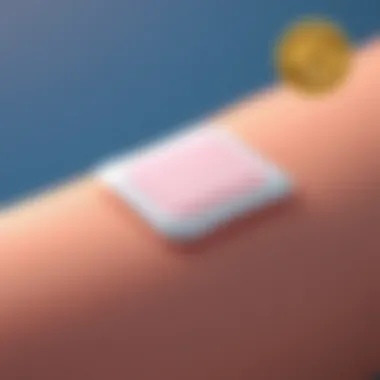Transdermal Estradiol Patches: Efficacy and Applications


Intro
In recent years, transdermal estradiol patches have gained traction as a pivotal component in hormone replacement therapy. For individuals navigating the nuances of hormonal imbalance, these patches present a unique and effective method of delivering estradiol, a primary form of estrogen. This article delves into the intricate workings of these patches, focusing on their mechanisms, efficacy, and implications for diverse patient groups.
The journey toward understanding transdermal estradiol therapy requires navigating some key terminology and concepts that underpin the science behind these patches. By grasping these foundational ideas, readers can better appreciate the implications and applications of this innovative treatment modality.
Prolusion to Hormone Therapy
Hormone therapy plays a crucial role in addressing various health issues, particularly those impacting hormonal balance in individuals. It encompasses a range of treatments aimed at supplementing or replacing hormones that the body may no longer produce adequately. This section serves as a foundational piece, setting the stage for understanding how hormone therapy can improve quality of life, alleviate symptoms, and contribute to overall well-being.
In this article, we will delve into the specifics of hormone replacement therapy (HRT) and examine its importance, especially concerning transdermal estradiol patches. It is essential to have a grasp of this topic, as it directly correlates with numerous conditions stemming from hormonal fluctuations, such as menopause, which affects countless women.
Overview of Hormone Replacement Therapy
Hormone Replacement Therapy refers to the clinical approach of supplementing hormones to restore balance in those experiencing deficiencies. It is predominantly prevalent in the context of menopause, where the body's estrogen levels decline significantly. The use of transdermal options, such as estradiol patches, offers tangible benefits compared to other forms of delivery, such as oral medications.
Notably, hormone replacement therapy can lead to an array of positive outcomes. Patients often experience:
- Alleviation of hot flashes
- Improved mood and cognitive function
- Enhanced skin elasticity
- Maintenance of bone density
- Reduction in the risk of developing osteoporosis
However, it is vital to approach HRT with caution. Potential risks, such as blood clots or certain cancers, must also be considered, making personalized treatment plans essential.
Role of Estradiol in Women's Health
Estradiol is the primary form of estrogen in the body, and its role in women's health cannot be overstated. This hormone supports several critical physiological processes, including the regulation of the menstrual cycle and the maintenance of pregnancy. Furthermore, it plays a significant part in maintaining bone health, cardiovascular function, and emotional well-being.
As women enter menopause, the sharp decline in estradiol levels can lead to numerous symptoms and long-term health risks. Therefore, understanding the protective roles of estradiol lays the groundwork for discussing the relevance of transdermal estradiol patches.
Estradiol not only helps in managing menopause symptoms but also plays a pivotal role in preventing chronic diseases.
Utilizing transdermal patches can effectively restore these crucial levels, allowing women to navigate menopause more comfortably.
In summary, hormone therapy, particularly through the use of transdermal estradiol patches, introduces new avenues for improving women's health—the ensuing sections will explore their composition, efficacy, and broader therapeutic applications.
Understanding Transdermal Estradiol Patches
Transdermal estradiol patches represent a significant advancement in hormone delivery methods, particularly for managing conditions like menopause and gender dysphoria. They're not just another option; they offer a unique approach that could resonate well within diverse patient populations. Understanding their composition, design, and functionality is crucial for both healthcare providers and patients alike.
Composition and Design
The transdermal estradiol patch is characterized by a few distinct components. Primarily, it features a polymer matrix that is designed to gradually release estradiol, the key hormone. This matrix is crafted to ensure an optimal absorption rate through the skin, minimizing waste and enhancing bioavailability. The adhesive used is also specially formulated to provide a secure bond, ensuring that the patch stays in place through daily activities, whether that means an afternoon jog or a busy workday.
Different brands, like Estraderm and Vivelle-Dot, have unique designs that include various sizes and shapes. Some are rectangular while others come in oval forms. This variety accommodates the needs and preferences of users, which is an often overlooked detail. Importantly, these patches are designed for ease of use; they can easily be applied to any hairless area of the skin, such as the thigh or abdomen.
Moreover, the patches are engineered with considerations for patient comfort and visibility. Many find that the discreet nature of these patches allows for more confidence in their use. The clear, low-profile design means they can blend in with the skin, making them less noticeable.
Mechanism of Action


The action of these patches is straightforward yet effective. Once affixed to the skin, estradiol is absorbed transdermally, bypassing the gastrointestinal system and liver. This is pivotal because if taken orally, estradiol is subjected to first-pass metabolism, where the liver could potentially reduce its efficacy. Instead, with transdermal administration, the hormone enters directly into the bloodstream, leading to quicker and more consistent hormone levels.
When estradiol is administered in this manner, it can produce a more stable serum concentration. This is significant as it helps alleviate fluctuations that can lead to undesirable side effects. Furthermore, the gradual release of the hormone mimics the body’s natural hormone secretion patterns, which can be crucial in managing symptoms effectively over time.
"Clinical evidence suggests that transdermal estradiol patches can significantly improve quality of life, particularly in areas such as mood and physical symptoms, for those undergoing hormone replacement therapy."
In summary, the understanding of transdermal estradiol patches encompasses their well-thought-out composition and their effective mechanism of action. Recognizing these elements can facilitate better conversations between patients and healthcare providers, fostering more informed decisions regarding hormone therapy. Armed with this knowledge, patients can approach treatment with more confidence and clarity.
Efficacy of Estradiol Patches
The efficacy of estradiol patches plays a pivotal role in the conversation about hormone therapy, particularly for women entering menopause or those undergoing gender-affirming treatments. Understanding how well these patches work is crucial, as it informs both prescribing practices and patient expectations. Estradiol patches can influence a patient's overall well-being, so investigating their clinical effectiveness and comparing them to alternative delivery methods lends valuable perspective to their use.
Clinical Studies and Outcomes
Clinical studies form the backbone of our understanding regarding the efficacy of estradiol patches. Research generally indicates that these patches provide a stable and consistent release of estradiol over time, which can effectively alleviate symptoms of estrogen deficiency, such as hot flashes, night sweats, and mood swings. For instance, a large-scale study published in The Journal of Clinical Endocrinology and Metabolism highlighted that women who used transdermal patches reported a 56% reduction in hot flash frequency compared to those on placebo.
Moreover, scrutiny of long-term outcomes reveals that patients using estradiol patches for hormone replacement therapy have shown improved bone density and lower incidences of osteoporosis-related fractures. This is particularly significant considering the potential long-term health implications associated with menopause. Gradually, the body adjusts, and the hormonal levels achieved through patches often result in a more balanced mood and enhanced quality of life.
"The consistent delivery of estradiol via transdermal systems has shown not just to ease menopausal symptoms but also to support long-term health in numerous studies."
Comparative Analysis with Other Delivery Systems
When comparing estradiol patches to other hormone replacement modalities, it becomes clear that their design offers distinct advantages. In particular, oral estrogen therapies are subject to first-pass metabolism by the liver, which can significantly alter hormone levels in the bloodstream. This first-pass effect can lead to erratic hormone levels and increased side effects, whereas estradiol patches bypass this avenue and deliver a more consistent hormonal level directly into the bloodstream.
Another popular route is the subcutaneous pellet, which has gained traction among practitioners and patients alike. While pellets can provide a sustained release of hormones, they require a minor surgical procedure for insertion, which can deter some individuals. Patches, on the other hand, are non-invasive, easy to apply, and offer flexibility that appeals to many users.
- Benefits of Estradiol Patches:
- Non-invasive and easy to apply
- Provide steady estrogen levels without the peaks and troughs associated with oral formulations
- No need for surgical intervention
Indications for Use
Understanding the indications for transdermal estradiol patches is pivotal for both healthcare providers and patients. These patches serve a significant role in various therapy contexts, allowing for tailored interventions that address hormonal imbalances and enhance patient quality of life. By aligning hormone therapy with the specific needs of different demographics, estradiol patches not only mitigate symptoms but also pave the way for a more personalized approach in treatment.
Menopause Management
Menopause can be a tumultuous phase, with symptoms that range from hot flashes and night sweats to mood swings and reduced sexual desire. Transdermal estradiol patches are an effective option for managing these symptoms. They administer estrogen directly through the skin, which avoids first-pass metabolism through the liver, ensuring a more consistent hormone level in the bloodstream. This can translate into a tangible difference in the quality of life of menopausal women.
Studies indicate that women using these patches often report significant relief from vasomotor symptoms, such as hot flashes, within weeks of starting therapy. In short, these patches can boost overall morale during a naturally challenging period. Women should ideally consult their healthcare provider to tailor a regimen that fits their specific health history and lifestyle preferences, making the management of menopause less of a hurdle.
Gender-Affirming Hormone Therapy
For many, the journey of gender identity involves complex and deeply personal shifts that require medical support, including hormone therapy. Estradiol patches provide a discreet and manageable means of administering hormones for transgender women and non-binary individuals. The transdermal delivery system allows for steady absorption, which mimics natural hormonal rhythms and minimizes fluctuations that can accompany other delivery methods.
In the context of gender-affirming therapy, these patches can contribute positively to physical and emotional well-being. Patients frequently note improvements in mood and body satisfaction, translating to an improved quality of life. Furthermore, the ease of application helps in encouraging adherence to treatment, a crucial element in achieving desired outcomes.
Other Therapeutic Applications


Aside from managing menopause and facilitating gender-affirming hormone therapy, transdermal estradiol patches can also be considered for other medical applications. For instance, they have been explored in treating certain hormone-related conditions, such as osteoporosis. Estradiol helps maintain bone density, making the patches a viable treatment option for individuals at risk of fractures due to age or other factors.
Moreover, some research indicates that these patches may play a role in managing premenstrual dysphoric disorder (PMDD), which presents severe emotional and physical symptoms affecting some women in their luteal phase. By stabilizing hormone levels, estradiol patches could potentially provide relief.
Overall, the versatility of transdermal estradiol patches highlights their importance across various therapeutic contexts. It is crucial to assess individual cases to maximize benefits while considering any risks or contraindications. Ultimately, a well-informed approach can empower patients to make decisions that enhance their well-being and align treatment with their unique situations.
Benefits of Transdermal Delivery
Transdermal delivery of medications, particularly estradiol patches, has grown in popularity for several reasons. This method allows for a route that sidesteps some of the complications typically associated with oral medication. In this section, we will delve into the pivotal benefits of transdermal delivery, discussing how it impacts efficacy, patient adherence, and overall health outcomes.
Reduced First-Pass Metabolism
One of the frontrunners among the benefits of transdermal delivery is its ability to bypass the liver's first-pass metabolism. When hormones are taken orally, they undergo significant metabolic processing by the liver before entering systemic circulation. This can worsen the efficacy of the medication, requiring higher doses to achieve desired effects. Conversely, administering estradiol via a transdermal patch delivers the hormone directly into the bloodstream, evading this metabolic phase entirely.
This change in absorption leads to better bioavailability of estradiol, meaning that a smaller amount of the hormone is needed to achieve therapeutic effects. For instance, studies have shown that women using patches often have more stable serum hormone levels compared to those utilizing oral tablets. This stability can translate to reduced side effects, a smoother hormone balance, and generally better outcomes in managing symptoms of menopause or other hormone-related conditions.
Overall, reduced first-pass metabolism optimizes the therapeutic potential of estradiol patches, turning them into a favored option for many practitioners and patients alike.
Steady Hormone Levels
Another significant advantage of transdermal estradiol delivery is the provision of steady hormone levels. Achieving stable hormone concentrations is crucial, especially in hormone replacement therapy, where fluctuations can lead to various physiological and psychological symptoms. For many individuals, these fluctuations might manifest as mood swings, hot flashes, or other distressing symptoms.
Transdermal patches release estradiol at a consistent rate over time. This continuous release avoids the peaks and valleys typically associated with other delivery methods, such as oral tablets, which can lead to changes in mood and physical symptoms.
Benefits of steady hormone levels include:
- Improved Symptom Management: Patients often report a reduction in severity and frequency of menopausal symptoms due to more even hormone levels.
- Enhanced Quality of Life: With fewer mood swings and physical discomfort, overall life satisfaction tends to improve for those undergoing transdermal therapy.
- Better Compliance: When patients feel more stable and symptomatic relief is palpable, they are more likely to adhere to their treatment regimen.
"The comfort and consistency of hormone delivery provided by patches should not be underestimated. They change the way many women experience hormone therapy, making it something manageable and not a trial and error process."
In essence, transdermal estradiol patches not only provide a more effective method for hormone therapy but also enhance the daily lives of those who rely on them. It is clear that the benefits of transdermal delivery extend beyond just the administration of estradiol, fundamentally transforming the landscape of hormone therapy.
Risks and Considerations
When discussing transdermal estradiol patches, it is crucial to recognize the inherent risks and considerations that come with hormone therapy. These patches, while effective in delivering hormones directly into the bloodstream, are not without potential drawbacks. Understanding these risks aids patients and healthcare providers in making informed choices about treatment options.
Evaluating the possible repercussions of using these patches not only helps in minimizing adverse outcomes but also enhances adherence to therapy through better education and awareness. The benefits of transdermal delivery, including steady hormone levels, must be cautiously weighed against the potential for side effects—an essential balancing act in the management of hormone therapy.
Potential Side Effects
Potential side effects, as with any medical treatment, are an important consideration when using transdermal estradiol patches. Although many patients tolerate these patches well, some may experience uncomfortable or serious reactions. Commonly reported side effects of estradiol patches include:
- Skin irritation at the application site, such as redness, itching, or rash.
- Nausea or vomiting, which can affect daily activities.
- Breast tenderness or changes, impacting physical comfort.
- Headaches or migraines, often exacerbated by hormonal fluctuations.
In rare cases, more severe side effects may occur. These can include:
- Increased risk of thromboembolic events: Hormonal therapies carry a risk of blood clots, which can lead to serious complications such as deep vein thrombosis or pulmonary embolism.
- Potential worsening of certain hormone-sensitive cancers, emphasizing the need for regular monitoring.
- Cardiovascular risks, particularly for individuals with pre-existing conditions.


Contraindications and Cautions
Addressing contraindications and cautions is equally important in ensuring the safe use of transdermal estradiol patches. Not every patient is an ideal candidate for hormone therapy. Specific groups of individuals need to exercise caution or avoid the use of these patches entirely:
- History of blood clots or stroke: Those with prior thromboembolic events should avoid estradiol patches due to increased risk.
- Certain cancers: Patients with a history of estrogen-sensitive cancers, such as certain types of breast or endometrial cancer, must be closely monitored or might require alternative treatments.
- Liver disease: Impaired liver function can affect hormone metabolism, leading to unpredictable effects.
- Cardiovascular disease: Patients with existing heart disease may face heightened risks associated with estrogen therapy.
Furthermore, practitioners must engage in a thorough assessment of individual health histories, alongside lifestyle factors such as smoking, alcohol use, and overall cardiovascular health. This individualization process is pivotal for creating a safe treatment plan, minimizing risks while maximizing the possible benefits of hormone therapy.
Informed decision-making leads to safer healthcare outcomes. Understanding both risks and benefits allows for a tailored approach to hormone therapy that responds directly to patient needs and health conditions.
Patient Perspectives and Experiences
Understanding the experiences of patients using transdermal estradiol patches is crucial for shaping hormone therapy practices. Patient perspectives offer a lens through which benefits, challenges, and overall satisfaction can be gauged. Gathering such insights provides valuable information about how these patches impact daily life, adherence to treatment, and long-term health outcomes. In this context, focusing on patient satisfaction and potential adherence issues naturally emerges.
Satisfaction and Quality of Life
For many individuals, the decision to use transdermal estradiol patches is fundamentally tied to improving daily life and enhancing overall well-being. Satisfaction with this mode of delivery is often linked to several factors:
- Ease of Use: Transdermal patches are typically straightforward to apply and remove, which stands as a significant advantage. Many patients appreciate the simplicity of wearing a patch rather than managing daily pills or injections.
- Consistency in Hormone Levels: Unlike oral forms, which can lead to fluctuating hormone levels, patches provide a more stable release of estradiol. This consistency can contribute to fewer mood swings, better energy levels, and overall improved mental health.
- Quality of Life Improvements: Reports from patients indicate substantial lifts in quality of life with the use of these patches. Symptom relief from menopausal issues or other hormone-related conditions can lead to more enjoyable daily activities and greater engagement in social settings.
"I couldn’t believe the difference it made. I went from feeling like a shadow of myself to actually enjoying time with my family again. All thanks to this patch!"
– A patient’s testament to transdermal estradiol efficacy.
Adherence Issues
While satisfaction is a positive indicator, the reality of adherence can be more complex. Several factors can contribute to challenges in consistently using transdermal estradiol patches:
- Skin Reactions: Some users have experienced dermatitis or localized irritation at the patch site. This discomfort can discourage consistent application, leading to lapses in treatment.
- Forgetfulness: The patch, once applied, is designed to remain in place for several days. However, patients may forget to change it on schedule, particularly if they don’t have a regular reminder or if life's busyness takes over.
- Variability in Lifestyle: For those with active lifestyles, situations like swimming, exercising, or traveling can complicate how patches adhere properly. This could result in patches coming off prematurely, thus interrupting treatment.
Adherence strategies can be tailored to individual needs, including integrating reminders into daily routines or exploring options for more adhesive formulations to minimize skin-related issues.
Patient perspectives shape the narrative around transdermal estradiol patches, revealing valuable insights that can enhance treatment protocols in hormone therapy. Addressing both satisfaction and adherence directly informs healthcare providers about the nuanced needs of their patients.
Future Directions in Hormone Therapy
As we navigate through the evolving field of hormone therapy, it becomes increasingly clear that there is a compelling need to explore future directions. This section delves into the cutting-edge developments and considerations in hormone therapy, specifically focusing on transdermal estradiol patches. The importance of this exploration lies in its potential to transform patient care, enhance treatment efficacy, and address individual needs in an ever-diversifying healthcare landscape.
Research in this area is not just advancing our understanding but also opens doors to more tailored approaches that consider unique patient backgrounds. What’s vital here is comprehending that hormone therapy isn’t a one-size-fits-all solution. As we unfold the layers, we look beyond convention and into what could redefine treatment paths for many.
Emerging Research and Innovations
The study of hormone therapy is continuously unfolding new paradigms. Recent research has started to emphasize not just the chemical aspects but also the biological responses of individuals to treatments. It’s fascinating how a particular individual may react differently to the same estrogen dose delivered via a patch compared to another. For instance, innovations such as microneedle patches are being explored, potentially increasing absorption and reducing skin irritation.
Furthermore, research is also investigating various estradiol formulations that cater to different metabolic responses and lifestyle factors. The integration of technology and patient monitoring is another frontier. Wearable devices are now capable of tracking hormonal levels in real-time, providing instant feedback and allowing for timely adjustments in dosage and regimen. This technology could pave the way for a more effective management of hormone replacement therapy, ultimately refining the approach to prescribing these treatments.
Personalized Approaches to Treatment
In the realm of hormone therapy, personalization plays a critical role. As healthcare shifts towards precision medicine, the ability to tailor hormone treatments based on genetic, environmental, and lifestyle factors is becoming increasingly important.
Consider the varying responses of individuals due to genetics. For example, polymorphisms in estrogen receptor genes can significantly impact how one metabolizes estradiol. A tailored hormone replacement strategy that takes such nuances into account can potentially minimize side effects while maximizing therapeutic benefits.
The implementation of individualized protocols also raises considerations about the involvement of healthcare providers. It’s essential that the clinicians understand not only the pharmacokinetics but also the unique attributes of each patient. This multifaceted approach ensures that patients receive the right type and dose of treatments that align with their health goals and personal histories.
"In a one-size-fits-all world, personalization brings forth the art of medicine in conjunction with the science."







